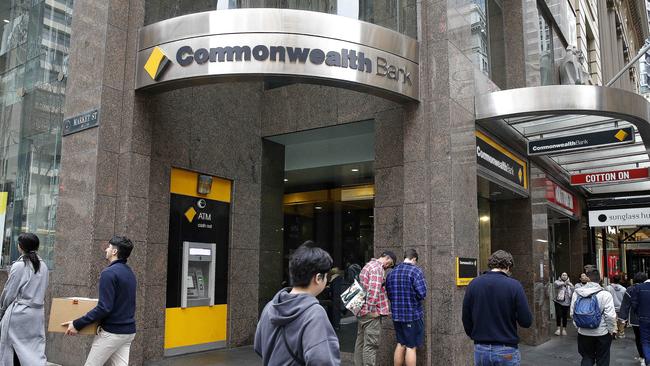Credit card accounts are disappearing, triggering sharp hikes in fees and rates
Credit card account numbers in Australia are in steep decline, spurring banks and other providers to hit consumers with more fees and interest to prop up their businesses.

Credit card account numbers in Australia are in steep decline, spurring banks and other providers to pull out all stops and hit consumers with more fees and interest to prop up their businesses. Banks have been particularly busy this year jacking up fees on credit cards and changing interest rates or other terms in the small print to bolster the profitability of their card operations.
It comes as banks struggle to eke out earnings growth and sections of the community endure a cost-of-living crisis.
While the credit card market isn’t in terminal decline, the rise of debit cards and buy now, pay later plus a bigger aversion to debt among younger age groups has exacerbated the market’s shrinkage.
The latest Reserve Bank data shows there were about 12.6 million personal credit and charge card accounts in Australia in June, almost two million fewer than five years ago.
Debt levels on credit cards have also notably reduced. Research and comparison site Canstar’s analysis shows the amount of debt accruing interest on personal credit cards in Australia peaked in early 2012 at $35.95bn and began to slide about seven years ago as buy now, pay later options gained traction.
The current figure stands at about $17.6bn in personal credit card debt attracting interest charges across the economy – a figure that has proven relatively stable for several years.
The underlying dynamics are, however, prompting a host of changes in credit card fees, rates and reward programs. Account holders certainly need to be alert to these and reassess whether this warrants a change of product or bank.
Canstar’s database shows, for example, that in May Commonwealth Bank cut the number of interest-free days on its reward cards to up to 44 days, from up to 55 days previously. From July, Macquarie Bank introduced a string of changes to some of its credit cards, including a reduction in the reward points customers earn per dollar spent.
National Australia Bank’s customers are not immune from changes, and from September 13 the bank is raising the interest rate on its low-fee card to almost 21 per cent, while also jacking up the annual fees on the NAB Qantas rewards premium and signature cards.
CBA-owned Bankwest is from this month removing free travel insurance from selected credit cards.
And it’s not just the banks getting in on the action.
Latitude’s global platinum MasterCard customers were recently informed they would be hit with a new $8 monthly card fee from mid-September, while the rate on purchases was increasing to just shy of 28 per cent. Attempting to soften the huge blow, Latitude said under a new rewards program customers would be eligible for a $10 e-gift card every month from participating retailers when they spent $1000 or more on eligible transactions during that period.

Canstar’s data insights director Sally Tindall says banks and other providers are looking for opportunities to make money where they can, particularly as credit cards have seen “better days” in terms of profitability.
She also notes banks are testing and introducing “different options” such as buy now, pay later-style credit cards which charged zero interest but often levied fees, in an attempt to attract younger customers.
Canstar’s database shows that over the past 12 months, 13 providers raised purchase rates across 60 credit cards. CBA, Westpac, NAB, ANZ, American Express and St George were among those.
Bankwest was the outlier as the only card issuer to decrease rates, albeit on just two card products over that period.
The average credit card purchase rate across almost 200 products monitored by Canstar sits at 17.66 per cent, compared to 17.04 per cent a year ago.
The RBA – over that same 12 months – raised the cash rate by 25 basis points in November last year.
Barrenjoey’s bank analyst Jon Mott last month quizzed CBA on a rise in consumer finance fee revenue and net interest income for fiscal 2024, asking the bank whether that reflected higher interest rates and fees, given personal loan and credit card balances were relatively flat over the period.
In response, CBA’s chief executive Matt Comyn said the higher income was linked to “a combination of both of those factors”.
The bank’s finance boss Alan Docherty added that in the six months to June 30, CBA “aligned the amount of interest-free days on our credit card product … that resulted in an interesting change from a volume/rate perspective. So, we’ve seen balances drop out but the overall … net interest earnings were improved as a result of that change.”
Both of those comments basically acknowledge that higher fees and a shorter interest fee period for credit cards helped to boost income in CBA’s retail bank.
NAB’s CEO Andrew Irvine tells this column he expects an evolution in the credit card and payments market rather than dramatic changes in coming years.
“There’s been a shift to debit, a slow and steady shift to debit and away from cash, and to some extent away from credit cards,” he says. “That will continue but it’s a slow and steady pace, so I don’t think there’s the narrative that in five years it’s (credit card market) going to be radically smaller …
“You’ve just got to continue to have propositions that customers value.”
NAB acquired Citigroup’s Australian consumer business about two years ago, so no doubt it’s positive on the fundamentals or wanted more scale.
The 2025 blues
The earnings reporting season through August was robust, with respectable profits reported across many sectors, despite the backdrop of sluggish consumer spending and a slowing economy.
The bigger question is how ASX-listed companies will fare in the 2025 financial year – which is already two months in. Potential rate cuts by the RBA will no doubt act as a swing factor when the central bank decides to pull the trigger on an easing cycle.
But if the RBA’s rhetoric is to be relied on, that’s some months away.
Strategists in Macquarie Group’s equity research unit have significantly lowered their earnings-per-share (EPS) expectations after the reporting season to a minuscule 0.1 per cent level of growth in fiscal 2025.
They had earlier anticipated an EPS recovery of almost 10 per cent.
“Resources are the biggest disappointment with a forecast fall of 3 per cent compared to a rise greater than 20 per cent back in April,” the strategists said. “Banks are the only group with upgrades of +2.1 per cent, but earnings are still forecast to fall about 3 per cent in FY25.”
Macquarie noted that just 5 per cent of larger ASX stocks reported an earnings beat for fiscal 2024, while delivering an upgrade to expectations for this financial year.
They included the likes of Block, owner of Afterpay, retailer JB Hi-Fi, telecommunications giant Telstra and Perth-based Lynas Rare Earths.
Across the ASX’s 100 largest stocks, Macquarie said some 16 per cent of profit results represented an earnings miss and also triggered downgrades to fiscal 2025 consensus analyst estimates. Those companies included QBE Insurance, health insurer NIB Holdings, real estate group Dexus, jobs platform SEEK, A2 Milk, Origin Energy, BlueScope Steel and Cochlear.
More Coverage
Originally published as Credit card accounts are disappearing, triggering sharp hikes in fees and rates




